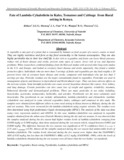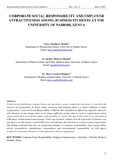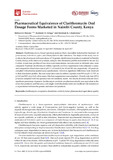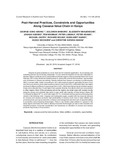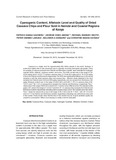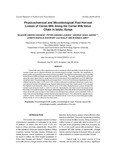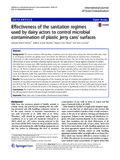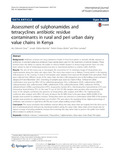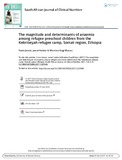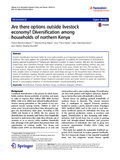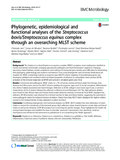Journal Articles: Recent submissions
Now showing items 2901-2920 of 29939
-
First complete genome sequences of porcine bocavirus strains from east Africa
(University of Nairobi, 2017)Here, we report the first complete genome sequences of two strains of porcine bocavirus (JOA_011 and JOA_015) detected in Uganda and Kenya, respectively. These data will help in understanding the molecular and evolutionary ... -
Factors associated with severity of neonatal sepsis during admission in Kenyatta national hospital paediatric wards, Kenya: a descriptive cross-sectional study
(University of Nairobi, 2017)Background: Neonatal sepsis is a major cause of neonatal mortality. In the year of 2012, it accounted for 44% of all deaths of underfive years old children globally. Statistics indicate that 98% of the global, one million ... -
Fate of lambda-cyhalothrin in kales, tomatoes and cabbage from rural setting in Kenya.
(University of Nairobi, 2017)A vegetable is any part of a plant that is consumed by humans as food as part of a savory course or me al. They are highly nutritious and form as key food com modity in the human consumption. ... -
Corporate social responsibility and employer attractiveness among business students at the university of Nairobi, Kenya
(University of Nairobi, 2017)In this era of globalization, winning the war for top talent to gain a competitive advantage is critical for th e survival of organization s . In Kenya today , attracting and retaining talent is a ... -
Antiplasmodial, cytotoxicity and phytochemical constituents of four maytenus species used in traditional medicine in Kenya
(2017)Background: In Kenya, several species of the genus Maytenus are used in traditional medicine to treat many diseases including malaria. In this study, phytochemical constituents and extracts of Maytenus undata, M. ... -
Pharmaceutical equivalence of clarithromycin oral dosage forms marketed in Nairobi county, Kenya
(University of Nairobi, 2017)Clarithromycin is a broad-spectrum semi-synthetic macrolide indicated for treatment of pneumonias, Helicobacter pylori, and chlamydial and skin infections. The object of this study was to evaluate the pharmaceutical ... -
Explore best practices in family nursing in Kenya: empathy as a value in caring
(University of Nairobi, 2016)Background: Study explored purposely selected 50 nurses’ empathy at Kenyatta National Hospital, Kenya, caring for persons sick & well in 3months using empathy, self-awareness in reflective practice. WHO, 2013 emphasis on ... -
Determinants of the adoption of technology in e-waste management at the Nairobi central business district
(Determinants of the adoption of technology in e-waste management at the Nairobi central business district, 2017)Electronic waste, also known as e-waste is a problem that is of growing concern to both developed and developing nations. E-waste contains multiple components and substances with dangerous toxins that may have adverse ... -
The food and beverage occurrence of furfuryl alcohol and myrcene—two emerging potential human carcinogens?
(University of Nairobi, 2017)For decades, compounds present in foods and beverages have been implicated in the etiology of human cancers. The World Health Organization (WHO) International Agency for Research on Cancer (IARC) continues to classify such ... -
Aflatoxin contamination in unrecorded beers from Kenya – A health risk beyond ethanol
(University of Nairobi, 2017)Samples of unrecorded opaque beers (n = 58; 40 based on maize, 5 on sorghum and 13 on other plants) and recorded wines (n = 8) in Kenya were screened for aflatoxins using a rapid ELISA technique followed by confirmation ... -
Post-harvest practices, constraints and opportunities along cassava value chain in Kenya
(University of Nairobi, 2016)Despite its great potential as a food, feed and for industrial application, its processing and marketing remains economically unexploited. A cross-sectional baseline survey was undertaken in Western (Migori and Busia) and ... -
Cyanogenic content, aflatoxin level and quality of dried cassava chips and flour sold in Nairobi and coastal regions of Kenya
(University of Nairobi, 2015)Cassava is a staple food for approximately 800 million people in the world. However, it poses food safety risks to the consumers due to naturally occurring cyanogenic glucosides. Thirty six samples of cassava products from ... -
Physicochemical and microbiological post-harvest losses of camel milk along the camel milk value chain in Isiolo, Kenya
(University of Nairobi, 2016)Camel milk value chain experiences a lot of constrains which are likely to leads to high post-harvest losses due to physicochemical and microbiological changes. However, the magnitude of these quality and quantity losses ... -
Sanitation and Hygiene Meat Handling Practices in Small and Medium Enterprise butcheries in Kenya-Case Study of Nairobi and Isiolo Counties
(University of Nairobi, 2015)In Kenya, meat handling practices among small and medium enterprise (SME) butcheries do not meet the minimum sanitation and hygiene standards. This exposes meat to contamination by spoilage and ... -
Effectiveness of the sanitation regimes used by dairy actors to control microbial contamination of plastic jerry cans' surfaces
(University of Nairobi, 2017)Background The most common milk handling containers used by dairy actors along the informal milk value chain in developing countries are plastics jerry cans which are difficult to effectively be cleaned thus contributing ... -
Assessment of sulphonamides and tetracyclines antibiotic residue contaminants in rural and peri urban dairy value chains in Kenya
(University of Nairobi, 2017)Background: Antibiotic residues are drug substances found in food from plants or animals initially exposed to antibiotics. In animal husbandry antibiotics have wide ly been used for the treatment of animal diseases. ... -
The magnitude and determinants of anaemia among refugee preschool children from the Kebribeyah refugee camp, Somali region, Ethiopia
(University of Nairobi, 2017)Background: Anaemia is a global public health problem affecting children from both industrialised and developing countries with major consequences for health, social and economic development. Although the burden of anaemia ... -
Are there options outside livestock economy? Diversification among households of northern Kenya
(University of Nairobi, 2016-02)Income diversification has been hailed by some policy-makers as an important ingredient for building pastoral resilience. This study applied the sustainable livelihood approach to establish the determinants of diversification ... -
Phylogenetic, epidemiological and functional analyses of the Streptococcus bovis/Streptococcus equinus complex through an overarching MLST scheme
(University of Nairobi, 2016)Background The Streptococcus bovis/Streptococcus equinus complex (SBSEC) comprises seven (sub)species classified as human and animal commensals, emerging opportunistic pathogens and food fermentative organisms. Changing ... -
East and West African milk products are reservoirs for human and livestock-associated Staphylococcus aureus
(University of Nairobi, 2017-08)Staphylococcus aureus frequently isolated from milk products in sub-Saharan Africa (SSA) is a major pathogen responsible for food intoxication, human and animal diseases. SSA hospital-derived strains are well studied but ...


